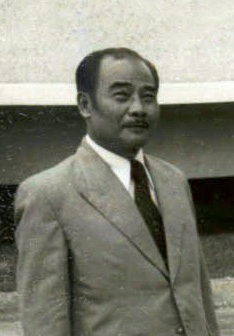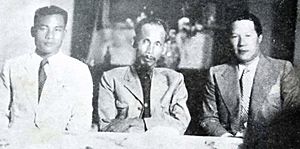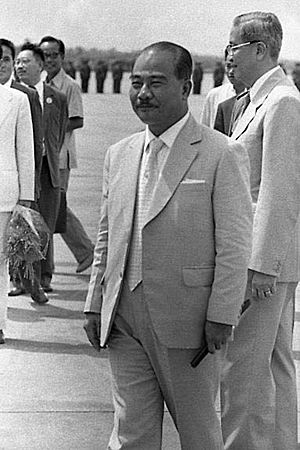Souphanouvong facts for kids
Quick facts for kids
Prince Souphanouvong
|
|||||||||||||||||||||||||||||||||||||||||||||||||||||||||||||||||||||||||||
|---|---|---|---|---|---|---|---|---|---|---|---|---|---|---|---|---|---|---|---|---|---|---|---|---|---|---|---|---|---|---|---|---|---|---|---|---|---|---|---|---|---|---|---|---|---|---|---|---|---|---|---|---|---|---|---|---|---|---|---|---|---|---|---|---|---|---|---|---|---|---|---|---|---|---|---|
|
ສຸພານຸວົງ
|
|||||||||||||||||||||||||||||||||||||||||||||||||||||||||||||||||||||||||||

Souphanouvong c. 1978
|
|||||||||||||||||||||||||||||||||||||||||||||||||||||||||||||||||||||||||||
| 1st President of Laos | |||||||||||||||||||||||||||||||||||||||||||||||||||||||||||||||||||||||||||
| In office 2 December 1975 – 29 October 1986 |
|||||||||||||||||||||||||||||||||||||||||||||||||||||||||||||||||||||||||||
| Prime Minister | Kaysone Phomvihane | ||||||||||||||||||||||||||||||||||||||||||||||||||||||||||||||||||||||||||
| Preceded by | Sisavang Vatthana | ||||||||||||||||||||||||||||||||||||||||||||||||||||||||||||||||||||||||||
| Succeeded by | Phoumi Vongvichit (Acting) | ||||||||||||||||||||||||||||||||||||||||||||||||||||||||||||||||||||||||||
| President of the Standing Committee of the Supreme People's Assembly | |||||||||||||||||||||||||||||||||||||||||||||||||||||||||||||||||||||||||||
| In office 2 December 1975 – 25 November 1986 |
|||||||||||||||||||||||||||||||||||||||||||||||||||||||||||||||||||||||||||
| Prime Minister | Kaysone Phomvihane | ||||||||||||||||||||||||||||||||||||||||||||||||||||||||||||||||||||||||||
| Preceded by | Position established | ||||||||||||||||||||||||||||||||||||||||||||||||||||||||||||||||||||||||||
| Succeeded by | Sisomphone Lovansay (Acting) | ||||||||||||||||||||||||||||||||||||||||||||||||||||||||||||||||||||||||||
|
|||||||||||||||||||||||||||||||||||||||||||||||||||||||||||||||||||||||||||
|
|||||||||||||||||||||||||||||||||||||||||||||||||||||||||||||||||||||||||||
| Personal details | |||||||||||||||||||||||||||||||||||||||||||||||||||||||||||||||||||||||||||
| Born | 13 July 1909 Palace Sisouvanna, Xieng Dong, Luang-Prabang, French Laos |
||||||||||||||||||||||||||||||||||||||||||||||||||||||||||||||||||||||||||
| Died | 9 January 1995 (aged 85) Vientiane, Laos |
||||||||||||||||||||||||||||||||||||||||||||||||||||||||||||||||||||||||||
| Citizenship |
|
||||||||||||||||||||||||||||||||||||||||||||||||||||||||||||||||||||||||||
| Nationality | Laotian | ||||||||||||||||||||||||||||||||||||||||||||||||||||||||||||||||||||||||||
| Political party | Lao People's Revolutionary Party | ||||||||||||||||||||||||||||||||||||||||||||||||||||||||||||||||||||||||||
| Other political affiliations |
Lao Front for National Development | ||||||||||||||||||||||||||||||||||||||||||||||||||||||||||||||||||||||||||
| Spouse |
Nguyen Thi Ky Nam
(m. 1938) |
||||||||||||||||||||||||||||||||||||||||||||||||||||||||||||||||||||||||||
| Relations | Lao Royal Family | ||||||||||||||||||||||||||||||||||||||||||||||||||||||||||||||||||||||||||
| Parents |
|
||||||||||||||||||||||||||||||||||||||||||||||||||||||||||||||||||||||||||
| Relatives |
|
||||||||||||||||||||||||||||||||||||||||||||||||||||||||||||||||||||||||||
| Education |
|
||||||||||||||||||||||||||||||||||||||||||||||||||||||||||||||||||||||||||
| Alma mater | |||||||||||||||||||||||||||||||||||||||||||||||||||||||||||||||||||||||||||
| Occupation |
|
||||||||||||||||||||||||||||||||||||||||||||||||||||||||||||||||||||||||||
| Awards | See list | ||||||||||||||||||||||||||||||||||||||||||||||||||||||||||||||||||||||||||
| Nickname | Red Prince | ||||||||||||||||||||||||||||||||||||||||||||||||||||||||||||||||||||||||||
| Military service | |||||||||||||||||||||||||||||||||||||||||||||||||||||||||||||||||||||||||||
| Allegiance | |||||||||||||||||||||||||||||||||||||||||||||||||||||||||||||||||||||||||||
| Commands | Commander | ||||||||||||||||||||||||||||||||||||||||||||||||||||||||||||||||||||||||||
| Battles/wars |
|
||||||||||||||||||||||||||||||||||||||||||||||||||||||||||||||||||||||||||
Prince Souphanouvong (13 July 1909 – 9 January 1995; Lao: ສຸພານຸວົງ), nicknamed the Red Prince, was along with his half-brother Prince Souvanna Phouma and Prince Boun Oum of Champasak, one of the "Three Princes" who represented respectively the communist (pro-Vietnam), neutralist and royalist political factions in Laos. He was the President of Laos from December 1975 to August 1991.
Contents
Early life
Souphanouvong was born in Palace Sisouvanna, Xieng Dong, Luang-Prabang. He was one of the sons of Prince Bounkhong, the last viceroy of Luang Prabang. Unlike his half-brothers, Souvanna Phouma and Phetsarath Ratanavongsa, whose mothers were of royal birth, his mother was a commoner, Mom Kham Ouane.
He attended the Lycée Albert Sarraut in Hanoi and then studied civil engineering at the École national des ponts et chaussées in Paris, and worked at a port in Le Havre. After graduating in 1937, he returned to Indochina and worked at the public works bureau in Nha Trang, where he was responsible for the construction of bridges and roads in central Vietnam and Laos. He worked as a civil engineer until 1945.
Political activities
Anti-colonial movement

After the Japanese surrendered at the end of World War II, he contacted the Viet Minh to seek their support for Lao independence and against the French colonial rule. In Hanoi, he also met with the leader of Viet Minh Ho Chi Minh, who greatly impressed him. As a result, Souphanouvong joined the Indochinese communist movement and became one of the leaders of the Lao Issara national liberation movement. He first served as its provincial chairman in Thakhek, then as foreign minister of the Lao Issara government and commander-in-chief of the Army for the Liberation and Defense of Laos (Armée de libération et de défense lao).
Unlike other members of the national liberation movement, Souphanouvong believed that Laos could only liberate itself from French rule in alliance with the Viet Minh and wanted Lao Issara and Việt Minh to unite in an Indochina-wide struggle against French rule. On 1 November 1945, Souphanouvong signed a Mutual Assistance Agreement between Lao Issara and Viet Minh. During the battle of Thakhek on 21 March 1946, Souphanouvong and his forces were defeated by the French, and as a result, he was wounded and fled across the Mekong River to Bangkok, Thailand. There, like other Lao Issara leaders, he remained in exile for the next three years. In March 1949 he resigned as foreign minister of the government-in-exile after conflicts over the issue of continued cooperation with the Viet Minh.
Leader of Pathet Lao
In August 1950, Souphanouvong convened the first congress of the Lao Freedom Front (Neo Lao Issara), more generally known as the Pathet Lao, which served as the vehicle for the communist challenge to French rule. It emerged from the radical wing of the Lao Issara in 1950 after the split and was supported by North Vietnam. On 13 August 1950, he was elected President of the Congress of the Lao Freedom Front, which met at the Viet Minh headquarters in Tuyen Quang, North Vietnam. As a result, became famous under the name "The Red Prince". However, the movement was led by the communist politician Kaysone Phomvihane and Souphanouvong was more of a figurehead in it.
Souphanouvong, at least initially, was not a committed communist. He joined the Pathet Lao because of personal conflicts with the Lao Issara leadership. In a conversation with a US diplomat in Bangkok in 1949, he described Laos as a "classless, Buddhist country in which communist theories had no basis." He proposed an independent Laos, with American help, as a neutral buffer against the spread of communism in Asia. It cannot be ruled out that Souphanouvong was actually so clueless, since the close circle of leaders of the Vietnamese and Laotian communists was extremely secretive and kept his Marxist-Leninist program strictly secret from outsiders, which probably included Souphanouvong. Radical goals such as dispossession, class warfare and abolition of the monarchy would not have appealed to the vast majority of the Laotian population with their Buddhist beliefs. However, all of Souphanouvong's statements was treated with caution, since according to two American contacts, he was a "perfect liar".
His pro-Vietnamese orientation was perhaps more decisive. He had spent much of his adult life, studying and working in Vietnam, and was married to a Vietnamese woman. As a result, he had more interactions with Vietnamese than with Laotians of his generation, and arguably a greater intellectual affinity with educated Vietnamese, whom he perceived as more dynamic, than with Lao elites, whom he described as apolitical and passive. He is thus part of a tradition of many aristocrats in Lao history who sought the support of one of the two large neighbors - either Thailand or Vietnam - in order to gain or retain power.
Souphanouvong joined the Lao People's Party (which later became the Lao People's Revolutionary Party) in 1955, but was not part of its leadership. However, he became chairman of the Lao Patriotic Front (Neo Lao Hak Sat), which was founded in 1956, and in which trade unions, women's and peasant associations were also represented. During the national unity government under his neutralist half-brother Souvanna Phouma, he was Minister for Planning, Reconstruction and Urban Development from 1957 to 1958. In May 1958, he was elected MP for Vientiane in the National Assembly of Laos with the highest number of votes among all candidates nationwide.
However, the unity government collapsed and the new government under Prime Minister Phoui Sananikone had Souphanouvong and other representatives of the Pathet Lao arrested in July 1959. In May 1960, the group managed to escape to the headquarters of the pro-communist forces at Sam Neua in Houaphan province. Souphanouvong continued to advocate for Pathet Lao-neutralist cooperation and contributed to the negotiations that led to the International Agreement on the Neutrality of Laos, which was signed in Geneva in 1962. In the second unity government that followed, Souphanouvong was appointed as Deputy Prime Minister and Minister of Economy and Planning. After the assassination of leftist Foreign Minister Quinim Pholsena on 1 April 1963, Souphanouvong left the government and retreated again to the Pathet Lao base in Sam Neua.
Only in 1967 did he publicly profess Marxism-Leninism. Whether this reflected his authentic ideological convictions or was a calculation of power remained questionable.
Souphanouvong tried again to create an alliance of Pathet Lao and neutralists to end the Laotian Civil War, in which his eldest son was killed. In 1972 and 1973, he was again involved in talks that led to the third unity government, in which he took over no ministerial office. However, he presided over the National Political Consultative Council, which drafted the 18-point program that guided the government's policies.
President of the Lao People's Democratic Republic
He was elected President of National Assembly from 1958 to 1959 following the success in the 1958 elections.
Upon its successful seizure of power in 1975, he became the first President of the Lao People's Democratic Republic, a position he held until 1991. After 1986, Phoumi Vongvichit acted in his stead as president, though Souphanouvong still retained the presidential title. Kaysone Phomvihane succeeded him as president in 1991. He was the President of the Supreme People's Assembly from 1975 to 1988.
In 1991, he became an Adviser of Party's Central Committee.
Later and personal life
He was married Le Thi Ky Nam, a Vietnamese woman who was the daughter of a civil servant. The two had ten children. Souphanouvong spoke eight languages, including Greek and Latin. His son, Khamsay Souphanouvong, escaped the country and applied for political asylum in New Zealand in 2000.
Souphanouvong died on 9 January 1995 in Vientiane, due to a heart disease. Following his death, the Laotian government decreed five days of mourning in his honor.
He is celebrated by the leadership of the Lao People's Democratic Republic and its press organs as a hero and "light figure" of the revolution and the Laotian nation. Especially on his 95th birthday in 2004, officials have increasingly emphasized his role in recent Laotian history and his services to the revolution, independence and national interests as well as the preservation of peace. He was buried in a stupa next to the Pha That Luang and in 2012, his remains were moved to the newly constructed national cemetery in Vientiane.
Honours and awards
Source:
 Laos:
Laos:
 People's Republic of Bulgaria:
People's Republic of Bulgaria:
 Cuba:
Cuba:
 Czechoslovakia:
Czechoslovakia:
 Mongolian People's Republic:
Mongolian People's Republic:
 Soviet Union:
Soviet Union:
 Vietnam:
Vietnam:
See also
 In Spanish: Souphanouvong para niños
In Spanish: Souphanouvong para niños


